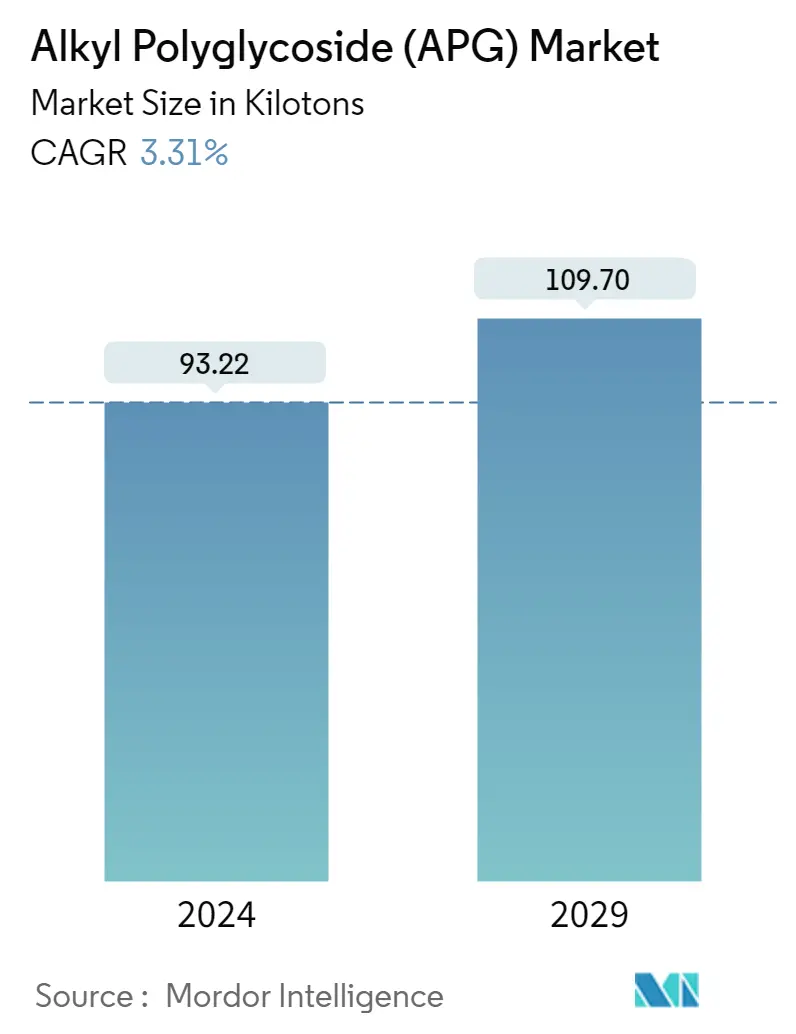Market Size of Alkyl Polyglycoside (APG) Industry

| Study Period | 2019 - 2029 |
| Base Year For Estimation | 2023 |
| CAGR (2024 - 2029) | 3.31 % |
| Fastest Growing Market | Europe |
| Largest Market | Europe |
| Market Concentration | Medium |
Major Players_Market_-_Logos.webp)
*Disclaimer: Major Players sorted in no particular order |
Alkyl Polyglycoside (APG) Market Analysis
The Alkyl Polyglycoside Market size is estimated at 93.22 kilotons in 2024, and is expected to reach 109.70 kilotons by 2029, growing at a CAGR of 3.31% during the forecast period (2024-2029).
The COVID-19 pandemic harmed the alkyl polyglycoside sector. Global lockdowns and severe rules enforced by governments resulted in a catastrophic setback as most production hubs were shut down. Nonetheless, the business is recovering since 2021 and is expected to rise significantly in the coming years.
- The major factors driving the market are a surge in demand for home care and personal care products and growing awareness of health hazards associated with conventional surfactants.
- Conversely, the availability of substitutes is expected to hinder the studied market's growth.
- A surge in the adoption of natural food ingredients is expected to act as an opportunity for the market studied.
- Europe represents the largest market and is expected to be the fastest-growing region over the forecast period. It is due to increased consumption from countries such as Germany, the United Kingdom, and France.
Alkyl Polyglycoside (APG) Industry Segmentation
Alkyl polyglycoside (APG) is a biodegradable ingredient derived mainly from coconut, and it is included in the class of non-ionic surfactants. It is extensively used as a surfactant that provides stable foam without producing filmy residue. The alkyl polyglycoside market is segmented by product, application, and geography. By product, the market is segmented into fatty alcohol, sugar, cornstarch, vegetable oil, and other products. The market is segmented by application into personal care and cosmetics, home care products, industrial cleaners, agricultural chemicals, and other applications. The report also covers the market size and forecasts for the alkyl polyglycoside market in 15 countries across major regions. Each segment's market sizing and forecasts are based on volume (tons).
| By Product | |
| Fatty Alcohol | |
| Sugar | |
| Cornstarch | |
| Vegetable Oil | |
| Other Products |
| By Application | |
| Personal Care and Cosmetics | |
| Home Care Products | |
| Industrial Cleaners | |
| Agricultural Chemicals | |
| Other Applications |
| By Geography | |||||||
| |||||||
| |||||||
| |||||||
| |||||||
|
Alkyl Polyglycoside (APG) Market Size Summary
The alkyl polyglycoside market is poised for steady growth over the forecast period, driven by increasing demand for eco-friendly and biodegradable surfactants in home and personal care products. The market is recovering from the setbacks caused by the COVID-19 pandemic, which had disrupted production and supply chains globally. The rising awareness of health hazards associated with conventional surfactants is propelling the demand for alkyl polyglycoside, particularly in regions like Europe, where it is expected to grow rapidly. The market's expansion is further supported by the growing consumer preference for natural and sustainable products, which aligns with the increasing adoption of alkyl polyglycoside in various applications.
The market landscape is characterized by a few key players, including BASF SE, Clariant, Croda International PLC, FENCHEM, and Dow, who hold significant market shares. These companies are actively expanding their production capacities to meet the rising demand. The European market, led by countries such as Germany, France, and the United Kingdom, is a major contributor to the market's growth, driven by the robust personal care and cosmetic industry. The stringent regulations governing the use of inorganic surfactants and the push towards bio-based alternatives further bolster the market's prospects. As consumer awareness and demand for naturally derived products continue to rise, the alkyl polyglycoside market is expected to witness substantial growth in the coming years.
Alkyl Polyglycoside (APG) Market Size - Table of Contents
-
1. MARKET DYNAMICS
-
1.1 Drivers
-
1.1.1 Surge in Demand for Home Care and Personal Care Products
-
1.1.2 Growing Awareness Toward Health Hazards Associated with Conventional Surfactants
-
1.1.3 Other Drivers
-
-
1.2 Restraints
-
1.2.1 Availability of Substitutes
-
1.2.2 Other Restraints
-
-
1.3 Industry Value Chain Analysis
-
1.4 Porter's Five Forces Analysis
-
1.4.1 Bargaining Power of Suppliers
-
1.4.2 Bargaining Power of Consumers
-
1.4.3 Threat of New Entrants
-
1.4.4 Threat of Substitute Products and Services
-
1.4.5 Degree of Competition
-
-
-
2. MARKET SEGMENTATION (Market Size in Volume)
-
2.1 By Product
-
2.1.1 Fatty Alcohol
-
2.1.2 Sugar
-
2.1.3 Cornstarch
-
2.1.4 Vegetable Oil
-
2.1.5 Other Products
-
-
2.2 By Application
-
2.2.1 Personal Care and Cosmetics
-
2.2.2 Home Care Products
-
2.2.3 Industrial Cleaners
-
2.2.4 Agricultural Chemicals
-
2.2.5 Other Applications
-
-
2.3 By Geography
-
2.3.1 Asia-Pacific
-
2.3.1.1 China
-
2.3.1.2 India
-
2.3.1.3 Japan
-
2.3.1.4 South Korea
-
2.3.1.5 Rest of Asia-Pacific
-
-
2.3.2 North America
-
2.3.2.1 United States
-
2.3.2.2 Canada
-
2.3.2.3 Mexico
-
-
2.3.3 Europe
-
2.3.3.1 Germany
-
2.3.3.2 United Kingdom
-
2.3.3.3 France
-
2.3.3.4 Italy
-
2.3.3.5 Rest of Europe
-
-
2.3.4 South America
-
2.3.4.1 Brazil
-
2.3.4.2 Argentina
-
2.3.4.3 Rest of South America
-
-
2.3.5 Middle-East and Africa
-
2.3.5.1 Saudi Arabia
-
2.3.5.2 South Africa
-
2.3.5.3 Rest of Middle-East and Africa
-
-
-
Alkyl Polyglycoside (APG) Market Size FAQs
How big is the Alkyl Polyglycoside (APG) Market?
The Alkyl Polyglycoside (APG) Market size is expected to reach 93.22 kilotons in 2024 and grow at a CAGR of 3.31% to reach 109.70 kilotons by 2029.
What is the current Alkyl Polyglycoside (APG) Market size?
In 2024, the Alkyl Polyglycoside (APG) Market size is expected to reach 93.22 kilotons.

